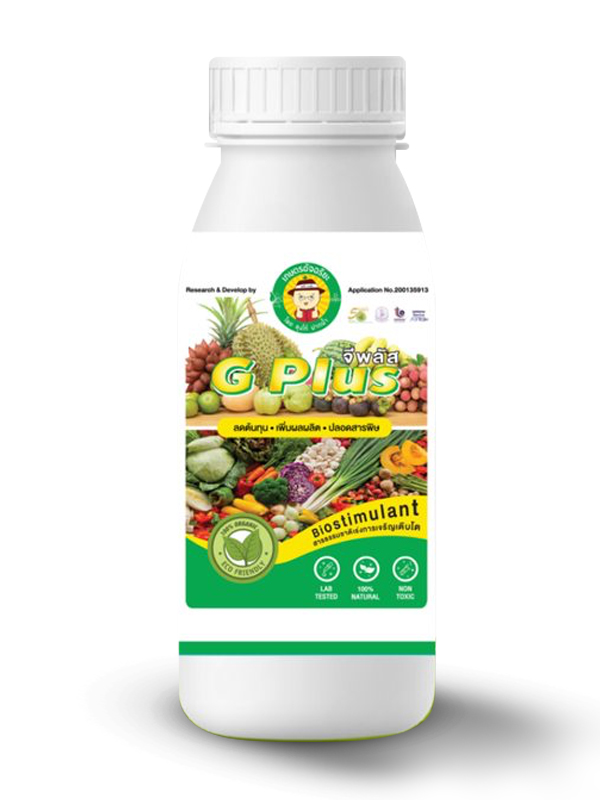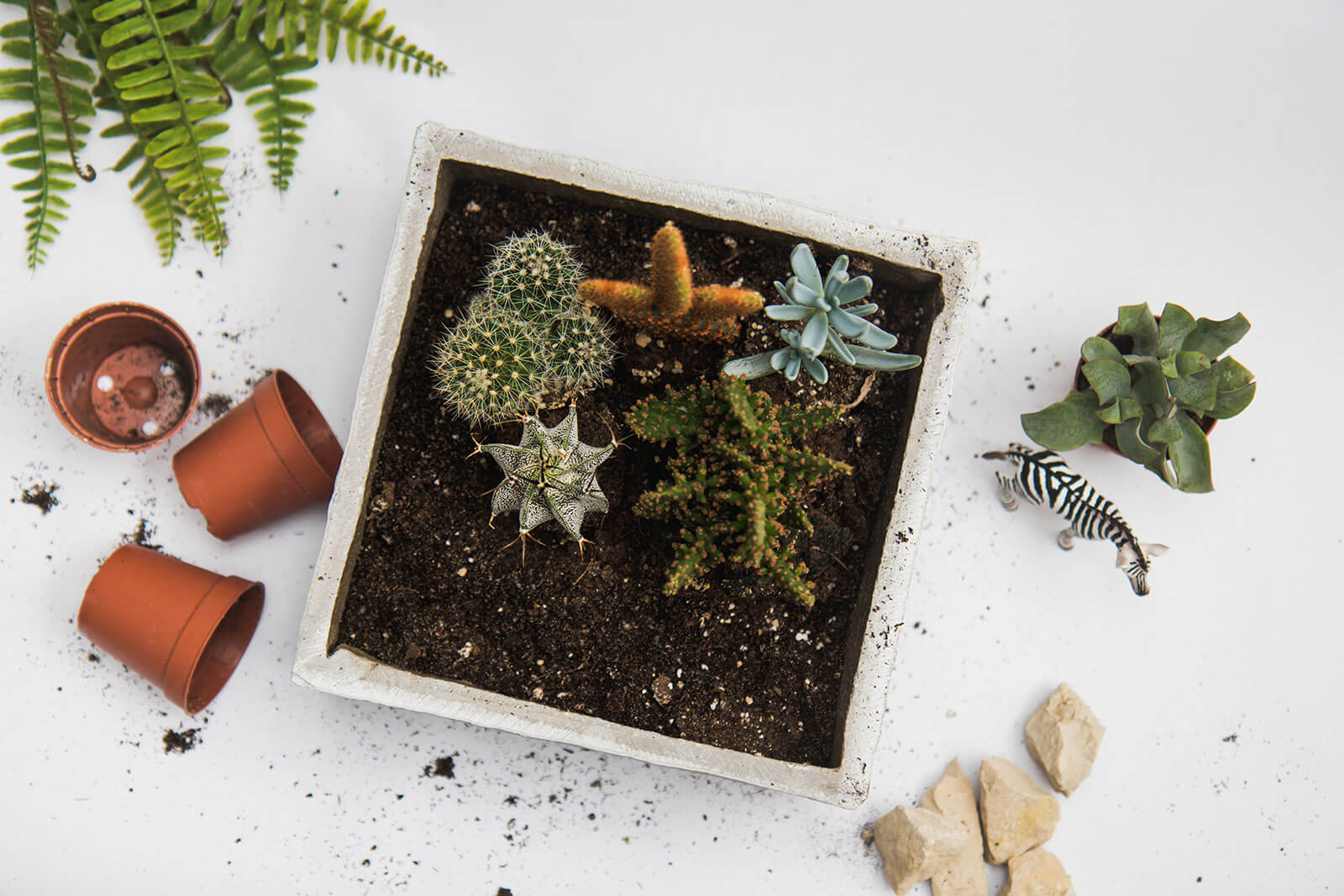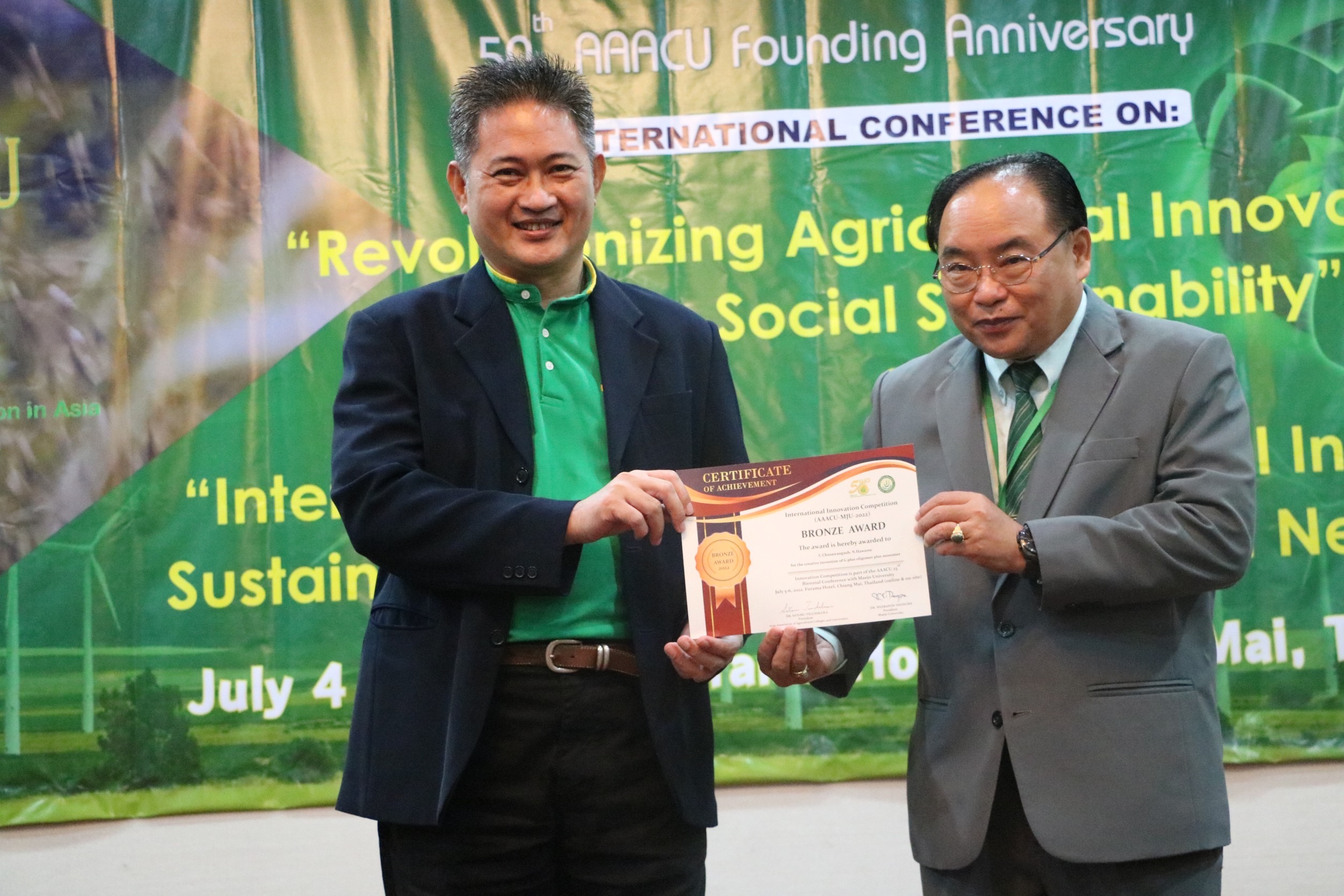G Plus
Petty Patent Application Number 2103000540
G Plus is an immune and plant growth stimulator. It is created from natural ingredients invented and researched by Dr. Pakpoom Vatcharakajon and the Kasetatchariya company’s research team. In 2022, the product got the Best of The Best award from the Department of Industrial Promotion, Ministry of Industry, and international innovation awards from innovation competition at the annual conference of the 23rd Asian Association of Agricultural Colleges and University (AAACU)
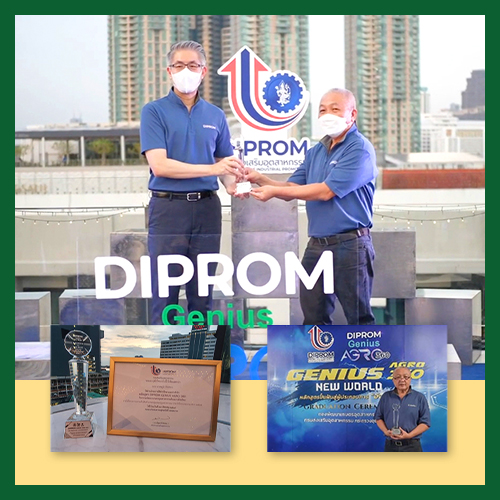
จากกรมส่งเสริมอุตสาหกรรม กระทรวงอุตสาหกรรม
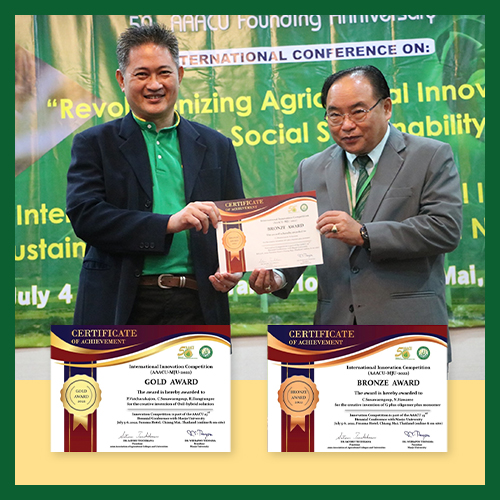
ในงานประกวดนวัตกรรม 23rd
Asian Association of Agricultural Colleges and University
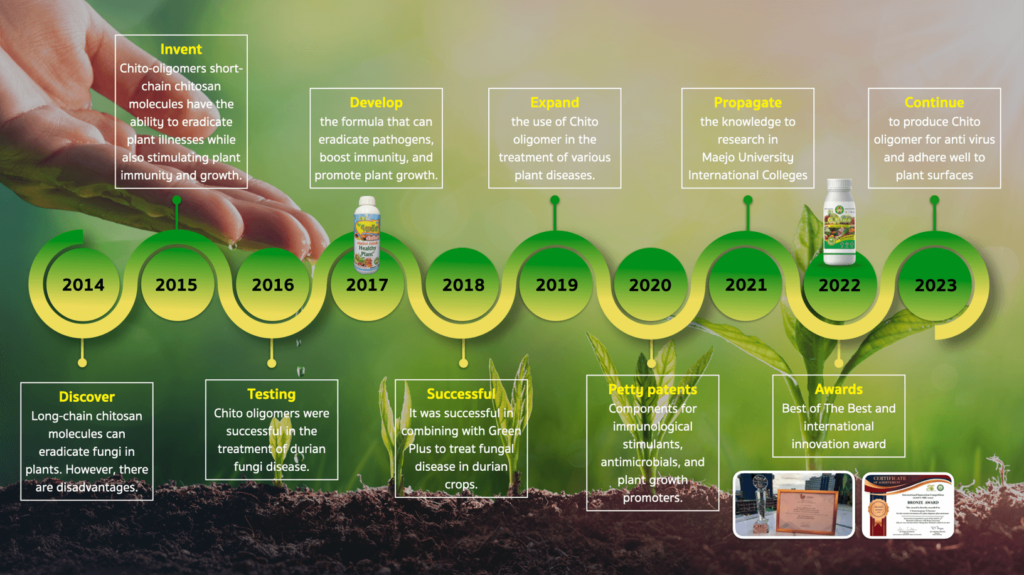
Chitosan oligomers, also known as Chito oligomers, are degradation of chitosan with a degree of polymerization (DP) less than 20 (e.g., DP6 = Hexamer, DP1 = Monomer) and an average molecular weight (MW) less than 3.9 kDa (normal range 0.2-3.0 kDa). It also has better solubility and remarkable properties such as biodegradability, biocompatibility, adsorptive capabilities, and non-toxicity like chitin and chitosan. (Liang, S. et al., 2018: Schmitz, C. et al., 2019)
G Plus primary constituents are Nanopolyglucosamine Oligomers, which are Chito oligomers and monomers (COAMs) with long and short-chain molecules, as well as a single molecule (monomer) which has a molecular weight that varies from 0.2 to 3 kDa. G Plus is purified and degraded using unique methods to create a nano molecule that plants can utilize instantly. According to research, compounds in this group of COAMs can enhance plants’ innate immunity, making them healthier, capable of fighting disease and pests on their own, and strengthening plant cell walls. These will result in stronger plant roots, stems, branches, and leaves, as well as increased yield for farmers.
Technological innovation available in G Plus
G Plus consists of five important innovative technologies termed “Canabichmo” (Ca-Na-Bi-Ch-Mo), which include:
- Cation technology is the combining of several positively charged atoms or groups of atoms together to make ingredients attach to plant cells faster and act rapidly.
- Nanotechnology is an extract that contains microscopic, nano-level fine compounds that can penetrate plant cell walls and stomata.
- Biotechnology is the extraction and preparation of substances using biological methods to improve safety for humans, animals, and the environment.
- Chelating technology is the protection of extracts from being easily degraded by other compounds, allowing them to act at their intended destination.
- Molecular technology is modifying and rearranging the extract molecules to get optimum performance, resulting in a substance that is highly pure and has a small molecular size, allowing plants to be absorbed into cells rapidly and benefit instantly.
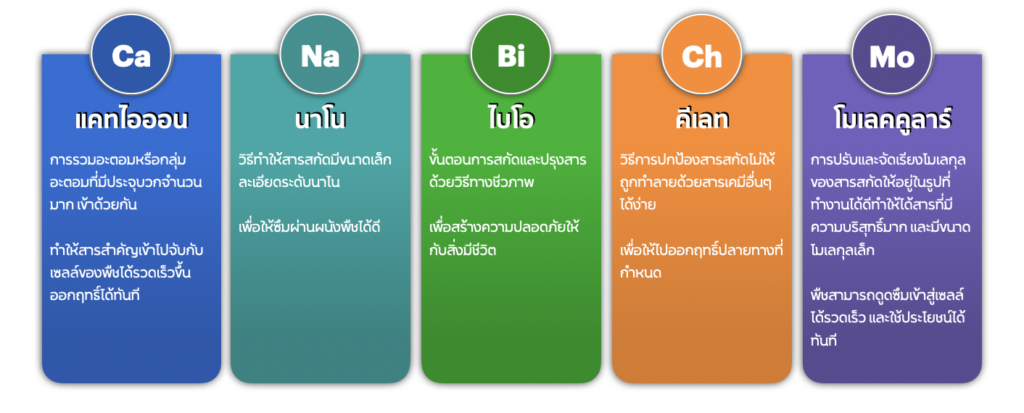
G Plus mechanism of actions
G Plus contains three methods of action including boosting the immune system of plants, antipathogens effects, and promoting plant growth. The details are as follows.
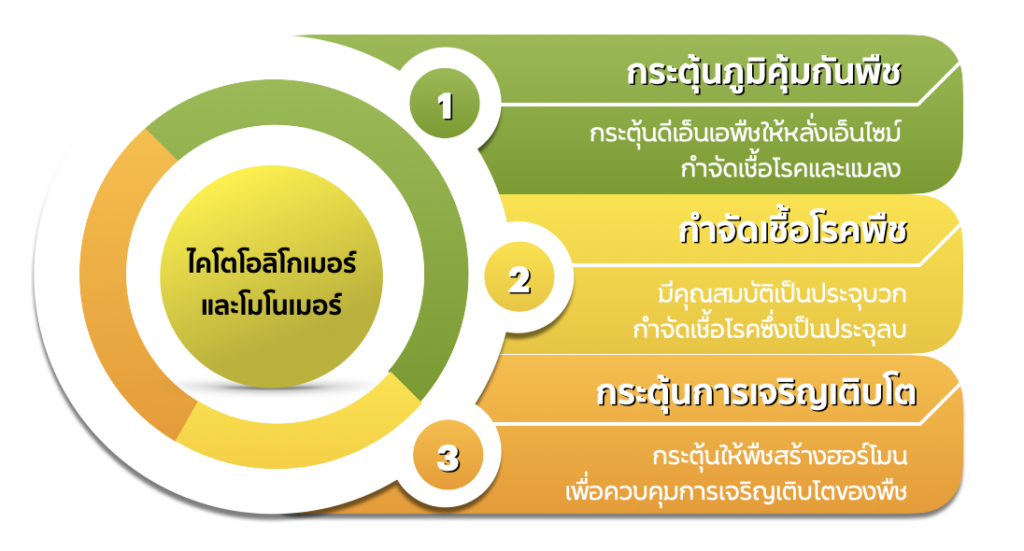
1. Plant Immunity Mechanism of Action
G Plus contains significant compounds such as Nanopolyglucosamine oligomers (nPGO), which include long-chain, short-chain, and single molecules (monomers). Each molecule will be performing the following actions:
- Long-chain molecules attach to plant tissue cell walls, increasing cell strength and functioning as antipathogens themselves.
- Short-chain molecules and single molecules (monomers) penetrate the plant cell wall and accumulate in the plant cell nucleus, where they bond to plant DNA, producing a complex substance called Nanopolyglucosamine Oligomers-DNA complex. These complex compounds activate the enzyme RNA polymerase, which is kept in chromatin, to produce more than 20 types of enzyme proteins, such as chitinase, beta-glucanase, and others, which can be released to eliminate foreign matter outside the cell, such as germs and pests. (Hadwiger, L.A. et al., 2017) Figure 1 depicts a model of G-Plus’s mechanism of action.
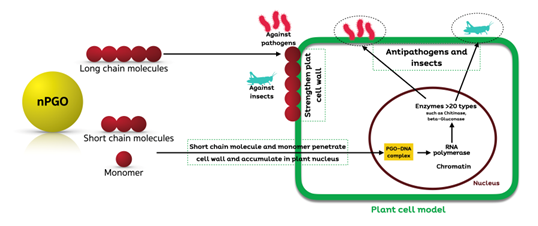
Plant cells normally synthesize all enzyme proteins in a limited amount when plants are invaded by foreign materials such as fungi and bacteria. However, when plant cells are stimulated by Nanopolyglucosamine Oligomer, the synthesis of plant enzyme proteins increases by 5 to 10 times. This will aid in the defense of foreign materials (germs and pests).
2. Mechanism of antipathogen activities
Chitosan oligomers can eliminate plant diseases such as fungi, bacteria, and viruses. The following is a key mechanism of action: (Ing, L.Y. et al., 2012: Ke, C.L. et al., 2021)
- Cation or positive charge: Chitosan oligomers have a positive charge. It may attach well to pathogen cell walls, which are usually negatively charged, causing the leaking of cellular contents, and ultimately killing the pathogens.
- Chelation: Chitosan oligomers exhibit chelating capabilities. It can attach to trace elements that are essential to pathogen survival, depriving pathogens of nutrition.
- DNA inhibition: Chitosan oligomers of small molecular and low molecular weights (LMW) can penetrate pathogen cell walls and bind to DNA to inhibit mRNA synthesis and have an impact on pathogen protein and enzyme production. Furthermore, chitosan oligomers were discovered to inhibit mitochondrial function and ATP production in fungi.
Figure 2 shows a model of the pathogen inhibition mechanism of chitosan oligomers. The process for gram-positive bacteria is depicted in Fig. 2A, gram-negative bacteria in Fig. 2B, and fungus in Fig. 2C.
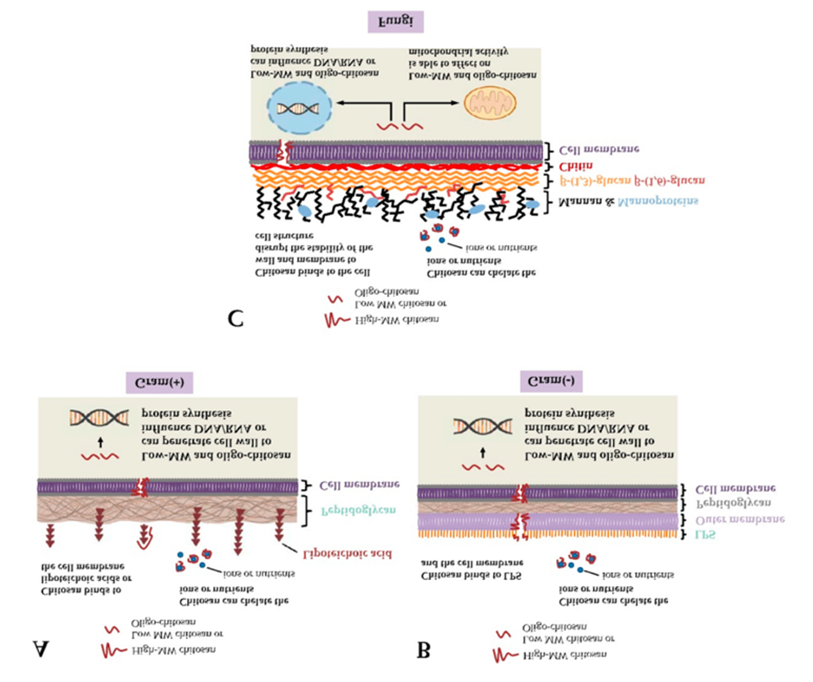
(Source: Ke, C.L. et al., 2021)
3. Plant growth stimulation
Chito-oligomer is a biostimulant that promotes growth in plants. It is a direct source of carbon (C) and hydrogen (H) for plants, and it influences the hormone system that regulates plant development, such as auxin. Figure 3 depicts the Chito-oligomer test for boosting plant growth.
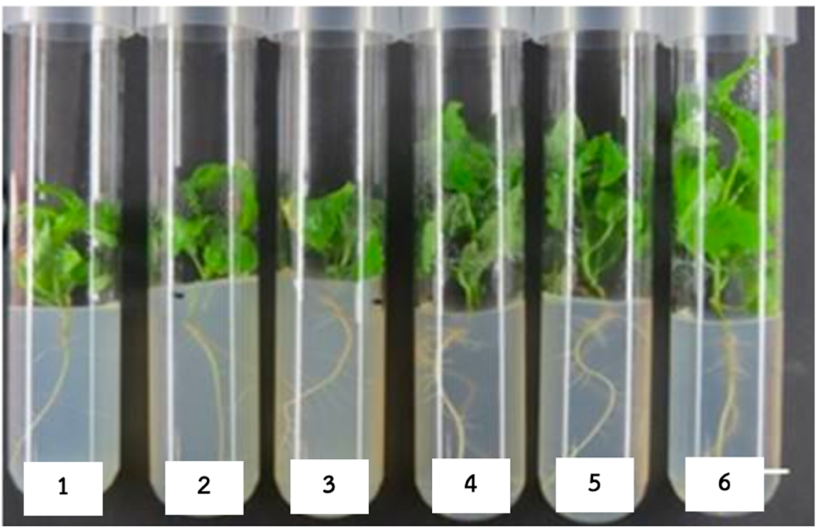
Tube 1-2: control group, tube 4-6 Chito-oligomer group
G Plus benefits
- Prevent disease of plants by inhibiting the fungus, bacteria, and viruses that cause plant diseases.
- Accelerate protein production and photosynthesis, and plant stress reduction.
- Accelerate plant growth and strengthen the plant.
- Aid in the creation of immunity against diseases and insects.
- Increasing quality and quantity of production.
- Stimulate immune and hormone function.
- Strengthens roots, stems, leaves, flowers, and fruits.
- Coating for vegetables or fruits to extend the shelf life.
G Plus usage rate
The usage rate depends on the purpose of application.
- Hormone replacement and plant immunity stimulation
- Mix G Plus 20 cc. with 20 liters of water.
- Used to eliminate fungi and form plant tissues.
- Mix G Plus 40 cc. with 20 liters of water.
- Spray around the trunk and the wound 3-5 times every 3-5 days, without rubbing
- Drone
- Mix G Plus 40-50 cc. with 16-20 liters of water.
How to spray G Plus
Farmers can spray G-Plus mixed with water in a variety of methods, including with a spray tank, using a sprayer, or drones. Because the molecules of G plus are so tiny, the spray approach requires adjusting the spray head to mist. It may pass through plant stomata and be utilized instantly. The best time to use is in the morning to before noon, or in the evening to before dusk.

The rate of use in each plant
| Plant types | Usage rate | How to use |
|---|---|---|
| Durian | 20 cc with 20 liters of water | Foliar spray, or via drip irrigation system, or tap on the soil every 15-30 days. |
| Rice crops | 20 cc with 20 liters of water | 1st spray: with grass-controlling chemical 2nd spray: rice is 1 month of age. 3rd spray: rice is 2 months of age. 4th spray: rice has a panicle of grain. |
| Field crops and orchards | 20 cc with 20 liters of water | Foliar spray every 7-10 days. |
| Vegetables | 20 cc with 20 liters of water | Foliar spray every 7-10 days. |
| Flower and ornamental | 20 cc with 20 liters of water | Foliar spray every 7-10 days. |
| Outbreak of diseases and insects | 40-50 cc. with 20 liters of water | Spray every 5 days until the signs of disease and insect infestation diminish. |
Other G Plus tips
- Can be used on different kinds of plants, and the amount used can be changed as appropriate.
- Can be used with other fertilizers and supplements that do not contain heavy metals.
- Can be used together with all pesticides. Spraying G Plus four hours before using pesticides.
Results of G Plus application
- Application in rice crops View Detail
- he treatment of durians root rot diseases View Detail
- The treatment of Citrus Greening Diseases-CGD (Huanglongbing-HLB) View Detail
- The treatment of fungal disease in pomelo crops. View Detail
- Other plant diseases treatment View Detail
References
- Hadwiger, L.A. 2017. Chitosan molecular-forms with potential in agriculture and medicine. J Drug Des Res, 4(2), 1036, 1-4.
- Ing, L.Y., Zin, N.M., Sarwar, A., Katas, H. 2012. Antifungal activity of chitosan nanoparticles and correlation with their physical properties. Int J Biomater., 632698. doi: 10.1155/2012/632698
- Jordan, G.J., Carpenter, R.J., Koutoulis, A., Price, A. & Brodribb, T.J. 2015. Environmental adaptation in stomatal size independent of the effects of genome size. New Phytologist, 205, 608–617. doi: 10.1111/nph.13076
- Ke, C.-L., Deng, F.-S., Chuang, C.-Y. & Lin, C.-H. 2021. Antimicrobial actions and applications of chitosan. Polymers, 13, 904. Available https://doi.org/10.3390/polym13060904
- Liang, S., Sun, Y. & Dai, X. 2018. A review of the preparation, analysis and biological functions of chitooligosaccharide. International Journal of Molecular Sciences, 19(2197), 1-19.
- Schmitz, C., González Auza, L., Koberidze, D., Rasche, S., Fischer, R. & Bortesi L. 2019. Conversion of chitin to defined chitosan oligomers: current status and future prospects. Marine Drugs, 17(8):452. Available https://doi.org/10.3390/md17080452
